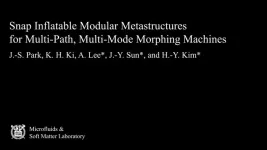(Press-News.org) A new type of soft robot can crawl like a worm, climb cables, and suddenly snap into a completely different shape to move in a new direction—all controlled by a single air input. This breakthrough, developed by researchers at Seoul National University, introduces a fundamentally new way for soft robots to move and adapt to their surroundings.
A Leap Forward in Soft Robotics
Soft robots, made from flexible materials, are known for their ability to bend and stretch. However, until now, they struggled to precisely control motion and required complex systems with multiple inputs to perform different tasks.
This new robot solves these challenges by using a snap-through mechanism, similar to how a toy jumping popper suddenly flips inside out or how a Venus flytrap quickly closes around its prey. The researchers designed a Snap Inflatable Modular Metastructure (SIMM) that allows the robot to both smoothly deform and rapidly snap into a new configuration—using just one air source.
Soft Robots That Move in Ways Never Seen Before
To demonstrate the power of this system, the team built two robotic designs:
♦ Crawling and Climbing Robot – This robot crawls across surfaces like an earthworm by expanding and contracting its body. Unlike existing soft robots, it can also grip and climb cables, making it useful for navigating difficult environments.
♦ Self-Reconfiguring Robot – This robot moves forward by bending, but then, with a sudden snap, it expands into a larger shape, enabling it to change direction and navigate complex terrain. This ability to move in different directions on demand has never been demonstrated in soft robotics before.
Opening New Possibilities for Adaptive Machines
With its ability to crawl, climb, and snap into new forms, this technology could lead to rescue robots that navigate through debris, medical robots that move inside the human body, and deployable structures that change shape on demand.
This groundbreaking study is published in Cell Reports Physical Science.
□ Introduction to the SNU College of Engineering
Seoul National University (SNU) founded in 1946 is the first national university in South Korea. The College of Engineering at SNU has worked tirelessly to achieve its goal of ‘fostering leaders for global industry and society.’ In 12 departments, 323 internationally recognized full-time professors lead the development of cutting-edge technology in South Korea and serving as a driving force for international development.
END
SNU researchers develop soft robot that crawls, climbs, and shape-shifts to move in new directions
Development of a reconfigurable soft robot that achieves movements never seen before in soft robotics
2025-02-11
ELSE PRESS RELEASES FROM THIS DATE:
Mystery solved: New study reveals how DNA repair genes play a major role in Huntington's disease
2025-02-11
A new UCLA Health study has discovered in mouse models that genes associated with repairing mismatched DNA are critical in eliciting damages to neurons that are most vulnerable in Huntington's disease and triggering downstream pathologies and motor impairment, shedding light on disease mechanisms and potential new ways to develop therapies.
Huntington’s disease is one of the most common inherited neurodegenerative disorders that typically begins in adulthood and worsens over time. Patients begin to lose neurons in specific regions of the brain responsible for movement control, motor skill learning, language and ...
Harvard Pilgrim Health Care Institute announces launch of Center for Sepsis Epidemiology and Prevention Studies (SEPSIS)
2025-02-11
Boston, MA – The Harvard Pilgrim Health Care Institute is proud to announce the launch of the Center for Sepsis Epidemiology and Prevention Studies (SEPSIS). This pioneering center of excellence is dedicated to advancing understanding, prevention, and management of sepsis, a life-threatening condition caused by a dysregulated immune response to infection.
The SEPSIS Center will be led by Dr. Chanu Rhee and Dr. Michael Klompas, internationally recognized leaders in sepsis surveillance, prevention, treatment, and policy. Both serve as faculty at Harvard Medical School and the Harvard Pilgrim Health Care Institute and bring a wealth of expertise and a shared commitment ...
New perspectives for personalized therapy of brain tumors
2025-02-11
Scientists from the German Cancer Research Center (DKFZ) and ShanghaiTech University have developed an innovative method for growing brain tumors of individual patients in the laboratory that mimic the original structure and the molecular property of the parental tumor as closely as possible. Drug tests in this model were found to correlate very well with actual patient responses, making it a valuable method for investigating therapies.
Tumor organoids, i.e. mini-tumors grown from surgical material in the culture dish, ...
IEEE researchers provide mathematical solutions to study 2D light interaction in photonic crystal lasers
2025-02-11
Laser diodes are semiconductors that generate light and amplify it using repeated reflection or ‘optical feedback’. Once the light has achieved desirable optical gain, laser diodes release it as powerful laser beams. Photonic crystal surface-emitting lasers (PCSELs) are advanced laser diodes where the optical gain is typically distributed laterally to the propagating light within a photonic crystal (PC) structure. They differ from traditional lasers by separating gain, feedback, and emission functions, offering scalable single-mode power and innovative ...
New joint project to investigate quantum repeaters designed to provide for secure quantum communication networks of the future
2025-02-11
There are reports of IT sabotage, cyber espionage, and other acts of hybrid warfare almost every day. Communication networks based on quantum physics could help eliminate threats of this kind. Researchers throughout Germany have already been working on developing those networks based on quantum repeaters for several years. In January 2025, the German Federal Ministry of Education and Research (BMBF) started funding a new research project, entitled Quantenrepeater.Net (QR.N), which aims to demonstrate the viability of quantum repeaters over test networks outside the protected lab environment. The BMBF will be providing a total of EUR 20 million over three years. ...
PhRMA Foundation welcomes two board members
2025-02-11
The PhRMA Foundation announced the appointment to its Board of Directors of Dr. John C. Reed, MD, PhD, Executive Vice President of Innovative Medicine R&D at Johnson & Johnson (J&J), and Dr. Donatello Crocetta, MD, MBA, Chief Medical Officer and Head of Medical Communities at UCB.
The PhRMA Foundation is a 60-year-old nonprofit that fosters biopharmaceutical innovation and value-driven health care by investing in the frontiers of research. The Foundation catalyzes the careers of promising researchers through competitive, ...
Microbiome as a potential key to better treatment: Clinical study on new therapy for Crohn's disease
2025-02-11
A special liquid diet, known as exclusive enteral nutrition, is an essential therapy for Crohn's disease. Patients consume only this formula for six to eight weeks, completely avoiding solid foods. However, the exact reasons why this is helpful were previously unclear. Researchers at the Technical University of Munich (TUM) and the LMU University Hospital Munich have now been able to decipher the mechanism behind this dietary therapy. Based on these results, they are launching a clinical study combining dietary therapy with faecal microbiome transfer to further enhance ...
AI predicts the precursor materials needed for material synthesis
2025-02-11
Researchers in Korea have developed a technology that automatically identifies the necessary precursor materials to synthesize specific target materials.
A joint research team led by Senior Researcher Gyoung S. Na from the Korea Research Institute of Chemical Technology (KRICT) and Professor Chanyoung Park from the Korea Advanced Institute of Science and Technology (KAIST) has developed an AI-based retrosynthesis methodology that predicts the required precursor materials solely based on the chemical formula of the target material without expensive material descriptors ...
International Shark Attack File Report: Unprovoked shark bites plummeted in 2024
2025-02-11
2024 was an exceptionally calm year for shark bites. Worldwide, there were only 47 unprovoked attacks, down 22 from the previous year and well below the 10-year average of 70. Four of last year’s attacks resulted in fatalities, also a significant reduction from recent years.
The International Shark Attack File, maintained by the Florida Museum of Natural History, provides data on what are considered unprovoked bites, defined as incidents in which a person does not initiate contact with a shark. Instances in which a person intentionally or unintentionally initiates contact, including spearfishing and releasing sharks ...
Ketamine for mental health should only be provided by trained professionals
2025-02-11
CHICAGO – The anesthetic ketamine is being hailed as a breakthrough therapy for people with post-traumatic stress disorder (PTSD), treatment-resistant depression and other mood disorders. But the drug does have side effects – some potentially life-threatening – and should only be prescribed and administered by trained health care professionals to ensure the patient’s safety, according to new guidance released by the American Society of Anesthesiologists (ASA).
Long valued for its role in sedation and anesthesia during medical procedures, ...
LAST 30 PRESS RELEASES:
How talking slows eye movements behind the wheel
The Ceramic Society of Japan’s Oxoate Ceramics Research Association launches new international book project
Heart-brain connection: international study reveals the role of the vagus nerve in keeping the heart young
Researchers identify Rb1 as a predictive biomarker for a new therapeutic strategy in some breast cancers
Survey reveals ethical gaps slowing AI adoption in pediatric surgery
Stimulant ADHD medications work differently than thought
AI overestimates how smart people are, according to HSE economists
HSE researchers create genome-wide map of quadruplexes
Scientists boost cell "powerhouses" to burn more calories
Automatic label checking: The missing step in making reliable medical AI
Low daily alcohol intake linked to 50% heightened mouth cancer risk in India
American Meteorological Society announces Rick Spinrad as 2026 President-Elect
Biomass-based carbon capture spotlighted in newly released global climate webinar recording
Illuminating invisible nano pollutants: advanced bioimaging tracks the full journey of emerging nanoscale contaminants in living systems
How does age affect recovery from spinal cord injury?
Novel AI tool offers prognosis for patients with head and neck cancer
Fathers’ microplastic exposure tied to their children’s metabolic problems
Research validates laboratory model for studying high-grade serous ovarian cancer
SIR 2026 delivers transformative breakthroughs in minimally invasive medicine to improve patient care
Stem Cell Reports most downloaded papers of 2025 highlight the breadth and impact of stem cell research
Oxford-led study estimates NHS spends around 3% of its primary and secondary care budget on the health impacts of heat and cold in England
A researcher’s long quest leads to a smart composite breakthrough
Urban wild bees act as “microbial sensors” of city health.
New study finds where you live affects recovery after a hip fracture
Forecasting the impact of fully automated vehicle adoption on US road traffic injuries
Alcohol-related hospitalizations from 2016 to 2022
Semaglutide and hospitalizations in patients with obesity and established cardiovascular disease
Researchers ‘listen in’ to embryo-mother interactions during implantation using a culture system replicating the womb lining
How changing your diet could help save the world
How to make AI truly scalable and reliable for real-time traffic assignment?
[Press-News.org] SNU researchers develop soft robot that crawls, climbs, and shape-shifts to move in new directionsDevelopment of a reconfigurable soft robot that achieves movements never seen before in soft robotics



